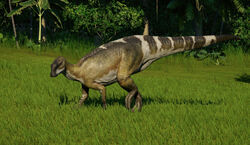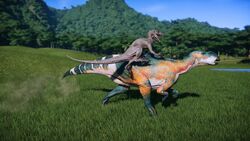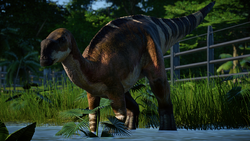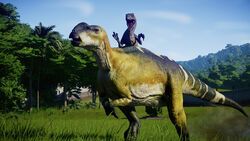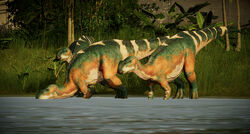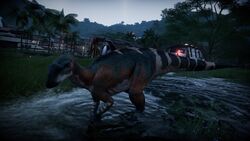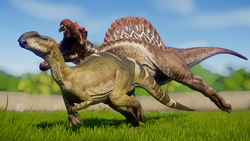| If it is possible for a dinosaur to be both elegant and awkward at the same time, then the Muttaburrasaurus takes the prize. This is a large herbivore that should make an excellent addition to our collection. |
Muttaburrasaurus is a genus of ornithopod dinosaur that originated from Early Cretaceous Australia. Named after the dig site of Muttaburra in Queensland, Australia, the sole dig site for the Muttaburrasaurus is the Mackunda Formation, which unlocks for expeditionary teams on Isla Sorna.
Characteristics
With its name meaning "Muttaburra Lizard" (named after the location of where it was first discovered; Muttaburra in Queensland, Australia), Muttaburrasaurus is a genus of medium herbivorous ornithopod (bird-like) dinosaur - measuring almost nine meters in length and weighing over three tons - notable for its flat skull and blunt snout. Able to primarily walking on all four legs but able to rear on its hind legs for speed, it had strong jaws and serrated shearing teeth, probably adapted for tearing leaves, branches and shrubs with ease and consuming tough plants like conifers and palms. The base genome is a greenish brown with white stripes along its tail and a bulbous nose.
Behaviour
Muttaburrasaurus is a very social animal and lives in groups of at least six other individuals to keep it comfortable. It mixes in well with other herbivores.
Muttaburrasaurus is a difficult animal to house due to their herd size requirements. They're more expensive than other hadrosaurid dinosaurs and slower to produce. This can cause delays in their introduction to an enclosure.
Paleontology
The first fossil of Muttaburrasaurus was discovered by cattle farmer Doug Landon in Queensland, Australia in 1963, when he unearthed parts of a skeleton next to the Thomson River in Muttaburra. His find was officially classified as a new genus in 1981 by Australian paleontologists Alan Bartholomai and Ralph Molnar, and further significant fossil finds have increased knowledge of the genus. The holotype specimen was discovered later in the Mackunda Formation in New South Wales.
Australia has only a handful of fossil formations containing dinosaurs compared to China or North America, due to the lack of glacial activity that uplifts fossils from lower strata. However, a fair number of dinosaur species have been found. Muttaburrasaurus is a special since it is known from an almost fully complete skeleton.
Originally believed to have been an Iguanodontid, similar to Iguanodon and Ouranosaurus, Muttaburrasaurus is now placed in the Rhabdodontidae family and is currently the largest genus in this family, measuring 26 feet long and weighing almost three tons. This branch of ornithopod dinosaurs retained primitive features, such as more pointed teeth designed for slicing plants rather than chewing them down to pulps as seen in other Cretaceous ornithopod families. Members of the Rhabdodontidae family lived in Australia and Europe, which were isolated from other parts of the world, while the more advanced hadrosaurs spread across the Americas and Asia.
The defining feature of the Muttaburrasaurus is its large hollow nasal cavity. This may have been used to amplify calls for communication. It may've also possessed an inflatable fleshy bag that could be used as a display feature or for intimidating predators. So far two species of Muttaburrasaurus have been found with differently sized nasal cavities. However, some palaeontologists consider these to be female and male Muttaburrasaurus, with the male having larger display cavity, while others theorize that the smaller species is a younger specimen.
Paleoecology
So far one of the only dinosaurs found at the Mackunda Formation, Muttaburrasaurus lived during the Early Cretaceous period, around 100-110 million years ago, travelling long distances across Australia in search of forest areas that could provide the vegetation they needed. It lived alongside many other Early Cretaceous dinosaur in Queensland, such as sauropods such as Diamantinasaurus and Wintonotitan, small armoured dinosaurs such as Kunbarrasaurus and Minmi, as well as the predatory theropod Australovenator, which may have preyed on Muttaburrasaurus. At the Dinosaur Cove formation in Victoria to the south, there was also a variety of smaller ornithopods such as Atlascopcosaurus, Leaellynasaura, and Qantassaurus. Australia was within the Antarctic circle during the Early Cretaceous and was at this time, one of the coldest places on Earth, with seasonal warm and very cold periods below freezing. The variety of dinosaurs living in this environment shows that these were highly adaptable animals and possibly warm blooded. Muttaburrasaurus' diet indicates their environment to be semi-arid with few waterways.
Available genomes
| Fossil icon | Dig site | Quality | Number available |
|---|---|---|---|
| Mackunda Formation | ★ ★★ ★★★ ★★★★ |
2 6 12 8 |
Skins
Gallery
External links
- Muttaburrasaurus on Wikipedia







